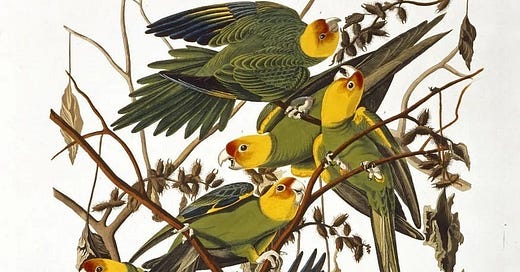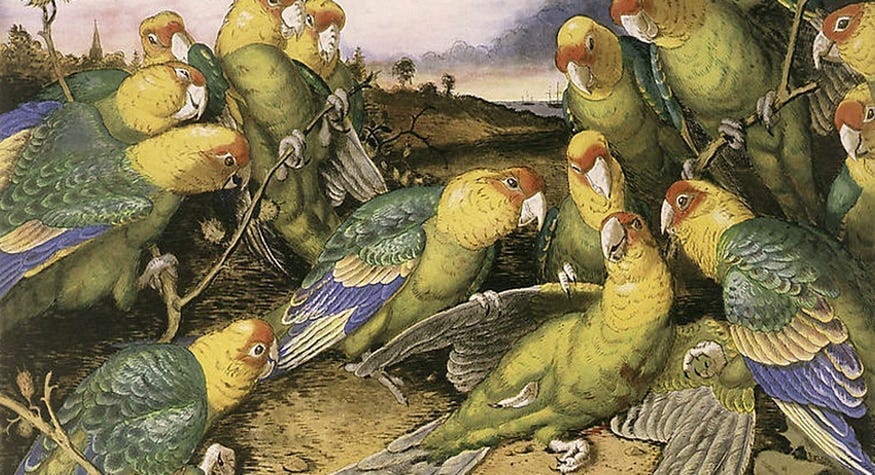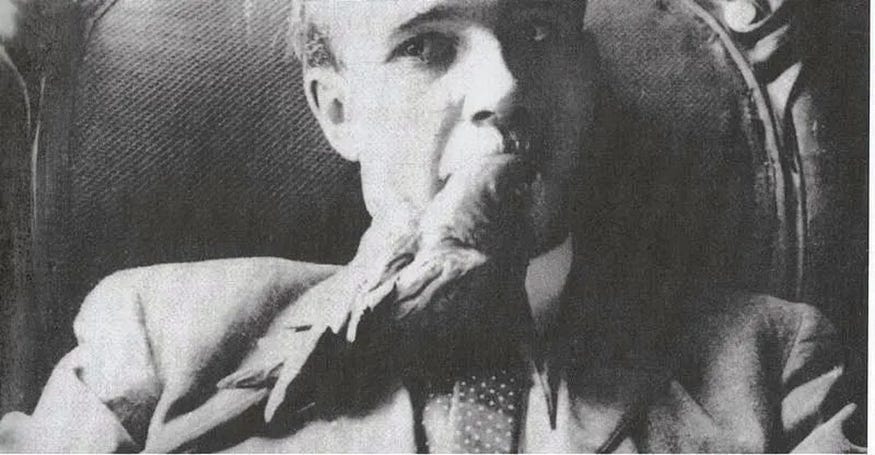The Carolina Parakeet
The Carolina parakeet, the only parrot native to its historic range, was officially declared extinct in 1939. But what do we know about this brightly colored and gregarious bird? And why did it ultimately vanish?
Noisy Flocks
Carolina parakeets, or Conuropsis carolinensis — Latin for “like a conure from Carolina” — were approximately 13 inches long and had a wingspan of 21–23 inches. They were adorned with feathers of brilliant green, yellow, and reddish orange.
The species was present in North America by 5.5 million years ago. Analysis of mitochondrial DNA, obtained from museum specimens, has also revealed that their closest living relatives include the sun, nanday, and golden-capped parakeets.
Since a proper scientific study was never conducted on the species while it was still extant, what we do know, or can surmise, about these parakeets has been cobbled together from a wide array of anecdotal historical accounts.
Several aspects of the Carolina parakeet’s behavior and ecology, such as its mating rituals, lifespan (possibly up to 20 years in the wild), and clutch sizes cannot be conclusively stated.
These highly social parakeets traveled in large flocks of up to 300 birds and were known for being extremely vocal, both during flight and while perched on tree branches-a fact that some enjoyed about the species, while others found it annoying.
Their call, as described by ornithologist Myron Swenk, is a “..shrill series of rapidly uttered, discordant cries, given incessantly when the birds were in flight, resembling qui-qui, qui, qui, qui, qui-i-i-i, with a rising inflection on each i and the last cry drawn out.”
The bird’s populations were made up of two subspecies: the midwestern Conuropsis carolinensis ludovicianus and the eastern Conuropsis carolinensis carolinensis.
At their peak, Carolina parakeets could be found in many southern states, including South Carolina, Florida, Texas, and Louisiana; as far north as Ohio, Indiana, New York, and Illinois-giving them the northernmost range of any parrot-and west into Kansas and Nebraska.
The Carolina parakeet had a preference for riparian woods, especially river-bottom deciduous forests such as cypress swamps, what 19th-century writers commonly referred to as “timbered streams.”
Their diet consisted of a variety of seeds, pecans, wild berries, grain crops (making them an agricultural nuisance to farmers), leaf buds, and cockleburs — their love of the latter’s toxic seeds made them poisonous to cats, according to ornithologists such as John James Audubon and Alexander Wilson.
They roosted together in hollowed-out dead or dying trees at night.
Historical Accounts
These memorable birds left an impression on all who saw them. This is just a sampling of the many surviving historical accounts that exist of the Carolina parakeet.
The earliest known reference to the species came from Sir George Peckham in A True Report of the Late Discoveries of the Newfound Lands (1583): “…do testify that they have found in those countries…parrots.”
Dutch settlers in New York were both confused and frightened by the sight of these brilliantly-colored parakeets in the dead of winter, assuming they were a bad omen.
Conversely, German settler Gert Goebel found the presence of the birds comforting and nostalgic.
Goebel wrote the following in his 1877 autobiography:
“These paroquets were a real ornament to the trees stripped of the foliage in the winter. The sight was particularly attractive, when such a flock of several hundred had settled on a big sycamore, when the bright green color of the birds was in such marked contrast with the white bark of the trees, and when the sun shone brightly upon these inhabited tree tops the many yellow heads looked like so many candles.
This sight has always reminded me vividly of a kind of Christmas tree which was used (in Germany) by the poorer families… When on Christmas Eve such a tree was decorated with gilded and silvered nuts and with apples and candies, it did not look unlike one of these bird-covered tree tops.”
Minister Timothy Flint (1780–1840), on seeing the birds during his travels in the Mississippi Valley, wrote: “We have seen no bird of the size, with plumage so brilliant; and they impart a singular magnificence to the forest prospect, as they are seen darting through the foliage, and among the white branches of the sycamore.”
Artifact discoveries, including an effigy pipe shaped like a Carolina parakeet found in a prehistoric burial mound, show that they were of spiritual significance to Native Americans as well.
Decline
Audubon remarked as early as 1832 about the noticeable decline of the once ubiquitous Carolina parakeet: “Our parakeets are very rapidly diminishing in number; and in some districts, where twenty-five years ago they were plentiful, scarcely any are now to be seen. I should think that along the Mississippi there is not now half the number that existed fifteen years ago.”
So what caused this rapid decline?
One factor appears to have been the introduction of the European honeybee by colonists. The bees quickly took up residence in the very same types of tree hollows that the parakeets preferred for nesting.
While Carolina parakeets were remarkably adaptable in many ways and could thrive even in subzero temperatures, they struggled to adopt new nesting behavior.
Deforestation and habitat loss undeniably played a large role in the population decline as well. Harvesting trees for wood fuel occurred frequently throughout much of the 19th century.
The regions where wood fuel harvesting was most prevalent as in forests along the Ohio and Mississippi rivers-were also the areas where the birds were rapidly vanishing during this era.
Thirdly, excessive hunting was responsible for the loss of countless Carolina parakeets as well.
Explorer John K. Townsend provided this haunting account of the ease with which one could hunt the birds: “They seemed entirely unsuspicious of danger and after being fired at only huddled closer together, as if to obtain protection from each other, and as their companions are falling around them, they curve down their necks and look at them fluttering upon the ground, as though perfectly at a loss to account for so unusual an occurrence.”
Because the parakeets would not abandon their fallen companions — and instead swarmed around them — it allowed for the wholesale slaughter of the poor unsuspecting birds.
They were killed for multiple reasons: by farmers protecting their crops, by collectors wanting to procure a specimen for their collections, for sport, and for their beautiful feathers which were in high demand in the millinery industry.
Domestication
The Carolina parakeet proved to be a friendly and very easily domesticated species. Because of this, several ornithologists captured their own flocks to observe and keep as pets.
Unfortunately, those who possessed a large number of the birds (who struggled with incubating and caring for their young in captivity) never attempted a captive breeding program — something that could have helped to bring the species back from the brink of extinction.
Smithsonian scientist Paul Bartsch adopted a baby Carolina parakeet from his friend and ornithologist Robert Ridgway’s flock. The sweet little bird, named Doodles, soon became a beloved member of the Bartsch family. Doodles would often crawl under the covers and snuggle with Bartsch and also had a toy squirrel that he loved to cuddle.
When Doodles passed away several years later, in 1914, Bartsch donated his body to the Smithsonian Museum.
The Last Wild Carolina Parakeet
The sources do not agree on when the last Carolina parakeet was killed in the wild — perhaps unsurprisingly, given that such things are nearly impossible to determine anyway.
By the early 20th century, the colorful birds were becoming vanishingly rare throughout much of their historic range.
Single birds were reportedly spotted infrequently in Atchison, Kansas, in 1904.
A lonely parakeet was seen perched outside of the Notch, Missouri, post office on July 18th, 1905.
According to Paul Hahn’s 1963 report, “Where is that Vanished Bird?”, a Carolina parakeet skeleton in the Smithsonian National Museum of Natural History is listed as belonging to a bird who was killed in Orlando, Florida, on August 14th, 1914.
In 1925, ornithologist Harold Bailey claimed that he knew of “a small colony (in Florida) but I do not expect it to last long, especially after this fact is published.”
Sightings of the endangered parakeets continued to be reported in South Carolina and Florida into the 1930s, but these could not be confirmed.
The American Ornithologists’ Union’s (AOU) Committee on Bird Protection wrote in 1939: “The persistent rumors that Carolina paroquets still survive in the southern swamps have been investigated with some care by the National Association of Audubon Societies and others, with negative results.”
However, a guide named Orsen Stemville captured a film of birds purported to be Carolina parakeets in Georgia’s Okefenokee Swamp in 1937. When the video was reviewed decades later, in 1970, by the AOU, the results were inconclusive. While these were clearly parrots of some kind, they couldn’t be definitively identified as the Carolina parakeet.
Incas and Lady Jane
For many years, the Cincinnati Zoo in Ohio was home to some of the last known remaining Carolina parakeets. The final pair, a male named Incas and his mate, a female named Lady Jane, had been a mated pair at the zoo for an amazing 32 years. Sadly, no photographs exist of either bird.
When Lady Jane passed away in the summer of 1917, Incas was reportedly despondent at the loss of his beloved mate and was still grieving when he himself died on February 21st, 1918.
The passing of Incas, the death knell for a species, received little attention, remaining in the shadow of the much larger topic of the day: World War I.
There are 720 skins and 16 skeletons of the birds preserved in museum collections around the world.
Interestingly, a recent exhaustive study, which utilized museum collections and historical records (including more than 700 records from a roughly 400-year period), indicates that the midwestern subspecies of Carolina parakeet likely died out by 1914, while its eastern counterpart may have persisted until the early 1940s.
Though our trees and skies can no longer be graced by flocks of these vibrant and adorable birds, the Carolina parakeet continues to fascinate and inspire.
If you would like to support my work and make a donation: Buy Me a Coffee
Other Sources
Hope is the Thing with Feathers: A Personal Chronicle of Vanished Birds, by Christopher Cokinos
(This article was originally published on Owlcation)








